Related Research Articles

Deforestation or forest clearance is the removal and destruction of a forest or stand of trees from land that is then converted to non-forest use. Deforestation can involve conversion of forest land to farms, ranches, or urban use. About 31% of Earth's land surface is covered by forests at present. This is one-third less than the forest cover before the expansion of agriculture, with half of that loss occurring in the last century. Between 15 million to 18 million hectares of forest, an area the size of Bangladesh, are destroyed every year. On average 2,400 trees are cut down each minute. Estimates vary widely as to the extent of deforestation in the tropics. In 2019, nearly a third of the overall tree cover loss, or 3.8 million hectares, occurred within humid tropical primary forests. These are areas of mature rainforest that are especially important for biodiversity and carbon storage.

Sumatra is one of the Sunda Islands of western Indonesia. It is the largest island that is fully within Indonesian territory, as well as the sixth-largest island in the world at 475,807.63 km2 (182,812 mi.2), including adjacent islands such as the Simeulue, Nias, Mentawai, Enggano, Riau Islands, Bangka Belitung and Krakatoa archipelago.
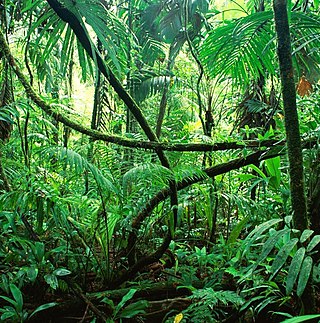
Rainforests are forests characterized by a closed and continuous tree canopy, moisture-dependent vegetation, the presence of epiphytes and lianas and the absence of wildfire. Rainforests can be generally classified as tropical rainforests or temperate rainforests, but other types have been described.

Tropical rainforests are dense and warm rainforests that occur in tropical rainforest climate where there is no dry season – all months have an average precipitation of at least 60 mm. True rainforests are typically found between 10 degrees north and south of the equator ; they are a subset of the tropical forest biome that occurs roughly within the 28-degree latitudes. Tropical rainforests are a type of tropical moist broadleaf forest, that includes the more extensive seasonal tropical forests.

Carbon offsetting is a carbon trading mechanism that allows entities such as governments or businesses to compensate for (i.e. “offset”) their greenhouse gas emissions. It works by supporting projects that reduce, avoid, or remove emissions elsewhere. In other words, carbon offsets work by offsetting emissions through investments in emission reduction projects. When an entity invests in a carbon offsetting program, it receives carbon credits. These "tokens" are then used to account for net climate benefits from one entity to another. A carbon credit or offset credit can be bought or sold after certification by a government or independent certification body. One carbon offset or credit represents a reduction, avoidance or removal of one tonne of carbon dioxide or its carbon dioxide-equivalent (CO2e).
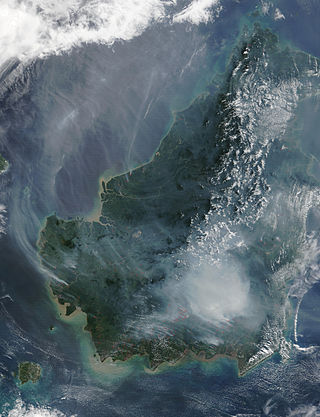
Peat swamp forests are tropical moist forests where waterlogged soil prevents dead leaves and wood from fully decomposing. Over time, this creates a thick layer of acidic peat. Large areas of these forests are being logged at high rates.

Gunung Leuser National Park is a national park covering 7,927 km2 in northern Sumatra, Indonesia, straddling the border of Aceh and North Sumatra provinces, a fourth portion and three-fourths portion, respectively. The national park, settled in the Barisan mountain range, is named after Mount Leuser (3,119 m), and protects a wide range of ecosystems. An orangutan sanctuary at Bukit Lawang is located within the park. Together with Bukit Barisan Selatan and Kerinci Seblat National Parks, it forms a World Heritage Site, the Tropical Rainforest Heritage of Sumatra.

The Borneo peat swamp forests ecoregion, within the tropical and subtropical moist broadleaf forests biome, are on the island of Borneo, which is divided between Brunei, Indonesia and Malaysia.
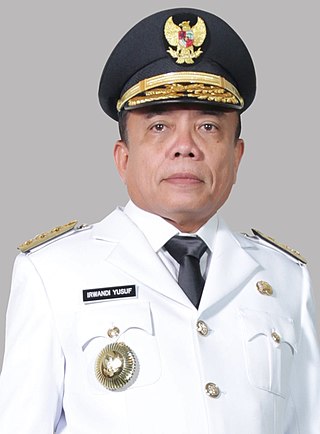
Irwandi Yusuf is an Indonesian politician who was the governor of Aceh. He was re-elected Governor in early 2017 after serving an earlier term between 2006 and 2012.

Asia Pulp & Paper (APP) is an Indonesian pulp and paper company based in Jakarta, Indonesia. One of the largest pulp and paper companies in the world, it was founded as Tjiwi Kimia by Eka Tjipta Widjaja in 1972. Asia Pulp & Paper is a subsidiary of Sinar Mas Group and was officially formed in 1994 when Sinar combined its paper and pulp operations from Tjiwi Kimia and PT Inda Kiat Pulp & Paper.
The Paiter, also known as Suruí, Suruí do Jiparaná, and Suruí de Rondônia, are an indigenous people of Brazil, who live in ten villages near the Mato Grosso–Rondônia border. They are farmers, who cultivate coffee.

Asia Pacific Resources International Holdings Limited, or APRIL, is a developer of fibre plantations and the owner of one of the world's largest pulp and paper mills with operations mainly in Indonesia and China. APRIL mainly produces bleached hardwood kraft pulp and uncoated, wood-free paper, including its Paperone brand of office paper. Founded in 1993, APRIL is managed by Royal Golden Eagle and owned by Indonesian business man Sukanto Tanoto living in Singapore. Royal Golden Eagle also manages companies in paper, palm oil, construction, and energy business sectors.
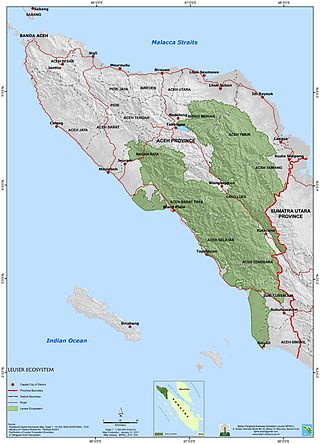
The Leuser Ecosystem is an area of forest located in the provinces of Aceh and North Sumatra on the island of Sumatra in Indonesia. Covering more than 2.6 million hectares it is one of the richest expanses of tropical rain forest in Southeast Asia and is the last place on earth where the Sumatran elephant, rhino, tiger and orangutan are found within one area. It has one of the world's richest yet least-known forest systems, and its vegetation is an important source of Earth's oxygen. Leuser also possesses more lowland rainforest than the rest of Sumatra combined and supports some of the last viable populations of tiger, rhino, orangutan and elephant.
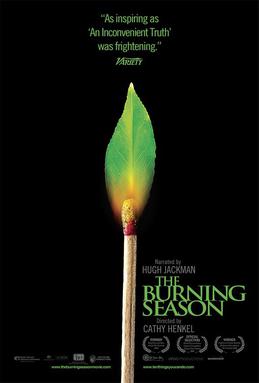
The Burning Season is a documentary about the burning of rainforests in Indonesia which premiered at the Tribeca Film Festival in 2008. The main characters featured in the film are: Dorjee Sun from Australia; Achmadi, a small-scale palm oil farmer from Jambi province in Indonesia; and Lone Drøscher Nielsen, a Danish conservationist based in Kalimantan, Indonesia.

Deforestation in Indonesia involves the long-term loss of forests and foliage across much of the country; it has had massive environmental and social impacts. Indonesia is home to some of the most biologically diverse forests in the world and ranks third in number of species behind Brazil and the Democratic Republic of Congo.
The Climate, Community & Biodiversity Alliance (CCBA) is a partnership consisting of Conservation International, CARE, The Nature Conservancy, Rainforest Alliance, and the Wildlife Conservation Society that is primarily active in the field of land management activities.

Deforestation in Borneo has taken place on an industrial scale since the 1960s. Borneo, the third largest island in the world, divided between Indonesia, Malaysia and Brunei, was once covered by dense tropical and subtropical rainforests.

Deforestation in Papua New Guinea has been extensive and in recent decades from 2001 to 2020, Papua New Guinea (PNG) lost 1.57Mha of tree cover, equivalent to a 3.7% decrease in tree cover since 2000, and 1.15Gt of CO₂e emissions.

Deforestation is a primary contributor to climate change, and climate change affects the health of forests. Land use change, especially in the form of deforestation, is the second largest source of carbon dioxide emissions from human activities, after the burning of fossil fuels. Greenhouse gases are emitted from deforestation during the burning of forest biomass and decomposition of remaining plant material and soil carbon. Global models and national greenhouse gas inventories give similar results for deforestation emissions. As of 2019, deforestation is responsible for about 11% of global greenhouse gas emissions. Carbon emissions from tropical deforestation are accelerating.
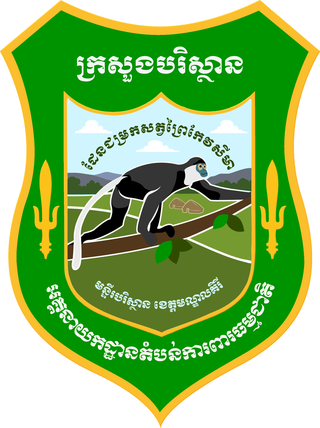
Keo Seima Wildlife Sanctuary is a 2,926.9 km2 (1,130.1 sq mi) protected area of mixed seasonal tropical forest in eastern Cambodia, located in Mondulkiri and Kratié provinces. The area was first established as Seima Biodiversity Conservation Area in 2002, later becoming Seima Protection Forest in 2009, finally becoming Keo Seima Wildlife Sanctuary in 2016. The site is of national, regional, and global importance for a range of biodiversity, with more than 950 species recorded within the protected area. It is also the ancestral and contemporary home of a large number of the Bunong ethnic group.
References
- ↑ Catalogue search (Science of student success), National Library of Australia.
- ↑ "AirCarbon Exchange". ACX.
- ↑ Walker, Cameron (20 June 2008). "Dorjee Sun: Rockin' for REDD!". Ecosystem Marketplace. Archived from the original on 10 July 2011. Retrieved 7 November 2010.
- ↑ "Ulu Masen REDD+ initiative, Aceh, Indonesia". REDD+ Case Book.
- ↑ "Burning Season: Full Episode". PBS.org.
- ↑ New chameleon species named after carbon conservation pioneer, Mongabay , published on 21 April 2009, accessed on 31 December 2011
- ↑ Asia 21 Fellows - Class 2011, Asia Society , accessed on 31 December 2011
- ↑ "The Code Online | International Commission on Zoological Nomenclature". www.iczn.org.
- ↑ "Heroes of the Environment 2009", Bryan Walsh, Time , published on 22 September 2009, accessed on 31 December 2011
- ↑ "Low targets, goals dropped: Copenhagen ends in failure". the Guardian. 19 December 2009. Retrieved 8 November 2021.
- ↑ "Waxman-Markey Short Summary". Center for Climate and Energy Solutions. 26 June 2009. Retrieved 8 November 2021.
- ↑ "Credits lost in tangle of Aceh's forest". The Sydney Morning Herald. 8 June 2012. Retrieved 8 November 2021.
- ↑ "East Asia Minerals Shifting Gears at Miwah Gold Property". Proactive Investors. 3 May 2010. Retrieved 24 September 2023.
- ↑ "A Technical Report on Exploration and Resource Estimation of the Miwah Project, Sumatra, Indonesia" (PDF). Baru Gold. 5 May 2011. Retrieved 24 September 2023.
- ↑ Colquhoun, Steve (31 May 2013). "The business of saving the planet". Sydney Morning Herald. Retrieved 24 September 2023.
- ↑ "East Asia Minerals Announces Acquisition of 50% of Carbon Conservation Pty Ltd". GlobalNewsWire. 3 May 2011. Retrieved 24 September 2023.
- 1 2 Bachelard, Michael (9 June 2012). "Credits lost in tangle of Aceh's forest". The Sydney Morning Herald .
- ↑ "East Asia Provides Update on Miwah Gold Project". Baru Gold. 8 November 2017. Retrieved 24 September 2023.
- ↑ Lang, Chris (March 2016). "REDDheads: The people behind REDD and the climate scam in Southeast Asia" (PDF). Stiftung Asienhaus.
- ↑ Walker, Cameron (20 June 2008). "Dorjee Sun: Rockin' for REDD!". Ecosystem Marketplace. Retrieved 24 September 2023.
- ↑ "Fire Free Alliance Checks Forest Fire & Haze in Over 200 Indonesian Villages". Inside RGE. 16 March 2017. Retrieved 24 September 2023.
- ↑ "Towards a Fire Free Future – Carbon Conservation Reviews APRIL's Fire Free Village Programme". April Dialog. 22 March 2017. Retrieved 24 September 2023.
- ↑ "Fire Free Alliance claims to have dramatically reduced forest fires in Sumatra since 2015". 16 March 2017. Retrieved 24 September 2023.
- ↑ "From UNSW to Silicon Valley: young entrepreneur attracts major funding". Australian Fintech. Retrieved 21 September 2023.
- ↑ "Founder Of $90 Million Cryptocurrency Hedge Fund Charged With Securities Fraud And Pleads Guilty In Federal Court". www.justice.gov. 4 February 2021.
- ↑ "Stefan He Qin's Sentencing Submission" (PDF). p. 6. Archived (PDF) from the original on 10 September 2021.
- ↑ "'Life was a video game': crypto fraudster sentenced". Australian Financial Review. 16 September 2021. Retrieved 23 September 2023.